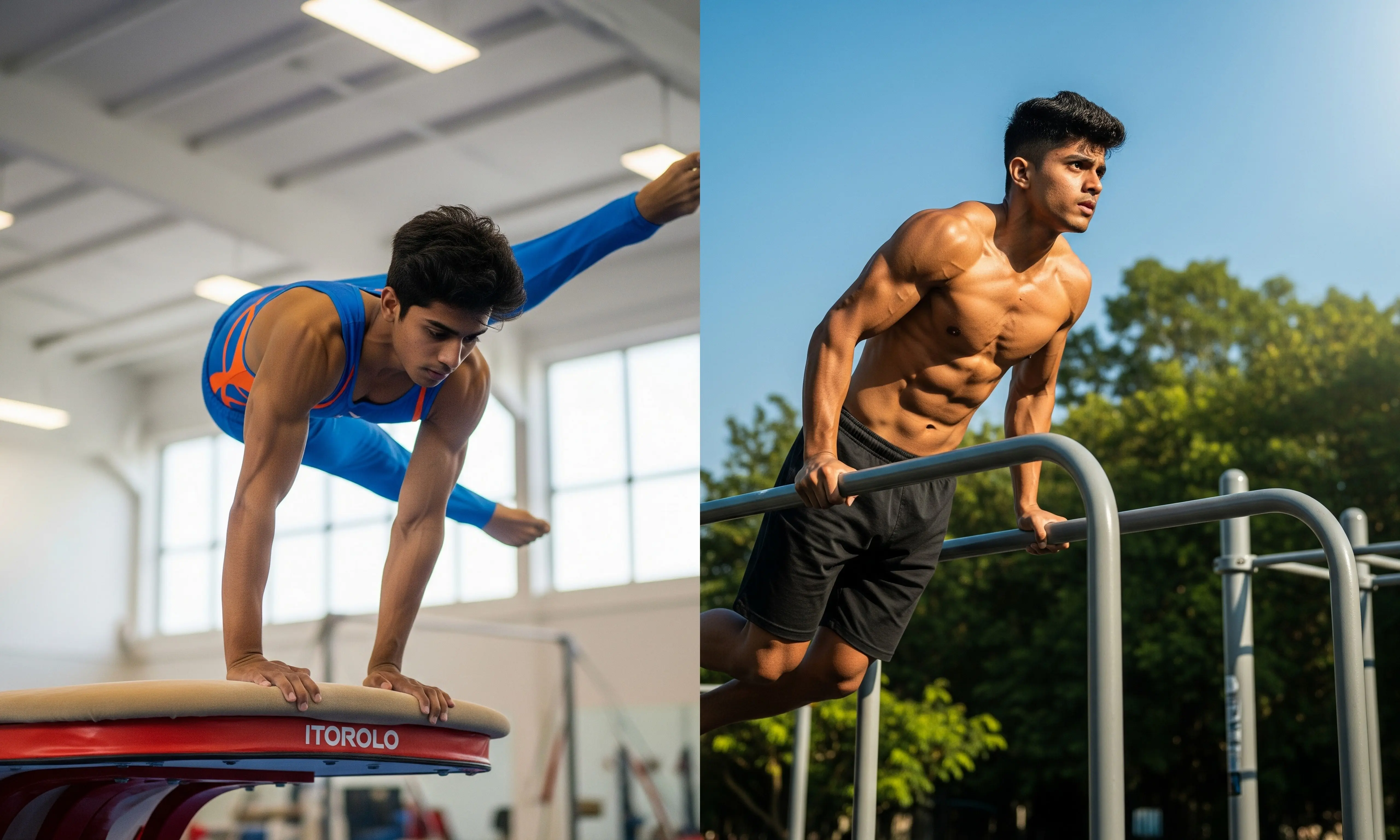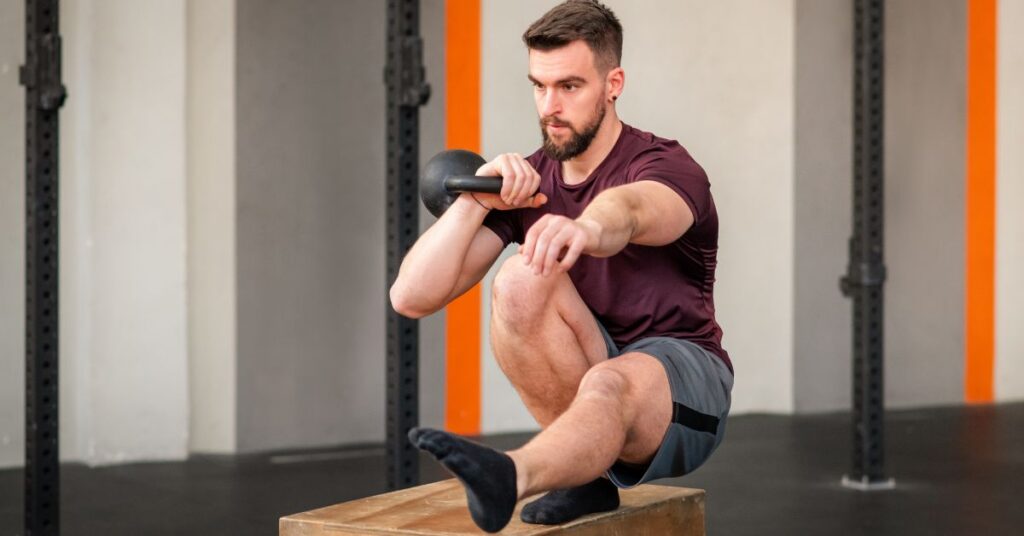Calisthenics vs gymnastics represents one of the most debated topics in bodyweight training. Both disciplines harness human movement without external weights, yet they diverge significantly in philosophy and application. Understanding the calisthenics vs gymnastics distinction becomes crucial for choosing the right path for your fitness journey.

What Is Calisthenics? A Functional Fitness Approach
Calisthenics workout methodology centers on functional movement patterns that translate to real-world strength. The discipline emphasizes practical strength through compound movements like push-ups, pull-ups, and squats. A structured calisthenics workout focuses on progressive overload principles, scaling from basic movements to advanced skills like muscle-ups and human flags.
Professional practitioners develop remarkable relative strength while maintaining lean physiques. Calisthenics exercises adapt to any environment, requiring minimal equipment while supporting advanced skill development through systematic progression.
What Is Gymnastics? A Sport of Precision and Artistry
Gymnastics transforms bodyweight movement into artistic expression while demanding technical precision. The discipline requires years of dedicated training under professional supervision, with athletes developing exceptional spatial awareness and explosive power. Competition involves specific apparatus work, routine memorization, and performance under pressure.
Elite gymnasts possess unique attributes including superior flexibility, explosive power, and body control. Training integrates strength development with flexibility maintenance, creating athletes capable of extraordinary feats while preserving joint health.
Similarities Between Calisthenics and Gymnastics
Both disciplines share fundamental bodyweight training principles. Core strength development remains paramount in both practices, as does bodyweight mastery and relative strength development. Progressive skill acquisition characterizes both pathways, requiring patience and consistent practice to achieve advanced movements.
Calisthenics vs Gymnastics: A Side-by-Side Comparison
This comprehensive comparison examines key differences in purpose, equipment requirements, progression methods, accessibility factors, and safety considerations to help you make an informed training decision. Understanding practical differences helps clarify which path aligns with individual goals.
Purpose and Goals: Fitness vs Performance
The calisthenics vs gymnastics debate centers on fundamental purpose differences. Calisthenics primarily serves fitness enhancement and general strength development. Practitioners seek improved functional strength and movement quality without competitive pressure.
Gymnastics operates within competitive frameworks where performance standards are externally defined. Athletes train for specific skills and competitive scores rather than general fitness, making the calisthenics vs gymnastics choice dependent on competitive aspirations versus personal goals.
Equipment and Environment: Minimalist vs Specialized
When comparing calisthenics vs gymnastics equipment requirements, differences become apparent. Calisthenics exercises require minimal equipment, often utilizing only pull-up bars or playground equipment. Training locations range from home spaces to outdoor environments, providing remarkable flexibility.
Gymnastics demands specialized apparatus, professional coaching, and dedicated facilities equipped with rings, pommel horses, and floor exercise areas. Equipment costs run thousands of dollars, while gym memberships command premium pricing.
Skill Progression: Scalable Movements vs Structured Training
The calisthenics vs gymnastics progression methodologies reveal philosophical differences. Calisthenics workout progression follows logical strength development patterns that practitioners can self-direct. Advanced calisthenics exercises build naturally from foundational movements through systematic overload.
Gymnastics progression follows sport-specific hierarchies preparing athletes for competition. Skills must be mastered in sequences for safety, requiring professional supervision throughout learning.
Accessibility and Cost: Outdoor Freedom vs Gym Commitment
Accessibility represents a major factor in the calisthenics vs gymnastics decision. Calisthenics exercises offer exceptional accessibility through minimal financial requirements and flexible scheduling. A comprehensive calisthenics workout can be completed anywhere with basic equipment.
Gymnastics requires significant investment including coaching fees, facility memberships, and competition expenses. The sport demands substantial time commitments exceeding twenty hours weekly, with geographic limitations potentially requiring relocation.
Risk and Injury: Which Is Safer for Long-Term Health?
Safety considerations impact the calisthenics vs gymnastics comparison significantly. Calisthenics exercises generally present lower injury risks due to natural movement patterns and progressive loading principles. The discipline emphasizes joint health through full range-of-motion exercises.
Gymnastics carries higher injury risks due to high-impact landings and extreme range-of-motion requirements. The sport places significant stress on joints, particularly wrists and shoulders, often resulting in chronic issues requiring ongoing management.
Prepare your body the right way with these essential Warm Up Exercises for Beginners and reduce your risk of injury.
Who Should Choose Calisthenics?
Calisthenics suits beginners, busy professionals, outdoor enthusiasts, and those seeking functional fitness without competitive pressure or significant financial investment in specialized equipment and coaching. Specific characteristics align better with calisthenics training approaches in the calisthenics vs gymnastics comparison.
Ideal for Beginners and Everyday Athletes
Calisthenics exercises provide excellent entry points through scalable progressions and forgiving learning curves. New practitioners can begin with basic movements and gradually increase difficulty without extensive technical instruction.
The calisthenics workout approach suits everyday athletes seeking functional strength without competitive pressures. Working professionals and students find calisthenics exercises easily integrated into existing schedules.
Perfect for Outdoor, Home, or Low-Equipment Training
Location independence makes calisthenics exercises ideal for travelers and home fitness practitioners. A complete calisthenics workout requires minimal space and equipment, enabling consistent practice regardless of circumstances.
Home practitioners appreciate the privacy and convenience of calisthenics exercises without gym dependencies. Parents can complete a calisthenics workout while supervising children, and professionals can train during limited time slots.
Benefits of Calisthenics for All Age Groups
Calisthenics exercises adapt well to different age groups through modifiable intensity levels. Older adults benefit from improved functional strength without high-impact stresses, while younger participants develop excellent movement foundations at appropriate paces.
Why Calisthenics Is a Gateway to Sustainable Fitness
The discipline creates sustainable fitness habits through enjoyable, challenging training that evolves with practitioners. Unlike repetitive routines, a well-designed calisthenics workout offers continuous skill development maintaining engagement throughout different life phases.
Who Should Choose Gymnastics?
Gymnastics appeals to competitive athletes, young starters seeking structured training, individuals desiring artistic expression, and those willing to commit significant time and resources for elite performance development.
Best for Competitive Athletes and Young Starters
Gymnastics suits individuals seeking competitive experiences and objective performance standards. Young athletes thrive in structured environments with clear progression hierarchies and expert coaching guidance that accelerates skill development.
Competitive aspects appeal to individuals motivated by external challenges and measurable achievements. Team environments foster camaraderie among dedicated athletes sharing similar goals.
Long-Term Dedication Gymnastics Requires
Gymnastics demands significant time commitments spanning decades of dedicated training affecting lifestyle choices. Participants must prioritize the sport above other activities to achieve meaningful progress in skill development.
Family commitment becomes essential for young gymnasts, with parents providing transportation, financial support, and emotional encouragement through challenging training periods.
Artistic Expression Meets Athletic Excellence
Gymnastics uniquely combines athletic achievement with artistic expression, appealing to individuals seeking creative outlets through physical movement. The discipline allows personality expression through routine choreography and performance style development.
Performance aspects develop confidence, stage presence, and artistic sensibilities extending beyond athletic achievement into personal development areas benefiting academic and professional interactions.
Gymnastics and Mental Discipline: A Hidden Advantage
The sport develops exceptional mental discipline through demanding training and performance pressure management. Athletes learn to overcome fear, manage anxiety, and perform under pressure while maintaining technical precision and artistic presentation standards.
Is Gymnastics Just Advanced Calisthenics?
While both use bodyweight training, gymnastics incorporates specialized apparatus, artistic elements, competitive judging standards, and technical requirements that extend far beyond advanced calisthenics exercises.
Debunking the Myth: Where They Overlap—and Where They Don’t
While both utilize bodyweight training, the calisthenics vs gymnastics comparison reveals gymnastics extends beyond advanced calisthenics exercises through sport-specific requirements and artistic elements. Gymnastics incorporates apparatus work and performance standards absent from typical calisthenics workout sessions.
The calisthenics vs gymnastics philosophical divide creates distinct training cultures and participant experiences extending beyond movement complexity into lifestyle choices and community dynamics.
Role of Coaching and Judging in Gymnastics
Professional coaching becomes essential due to safety requirements and technical complexity. Coaches provide progression planning and safety supervision unavailable through self-directed calisthenics workout approaches.
Judging systems create objective performance standards driving training focus, fundamentally altering approaches compared to self-directed calisthenics exercises emphasizing personal progression.
Freestyle vs Form: A Philosophical Divide
The calisthenics vs gymnastics comparison reveals differences in creative expression. Calisthenics exercises celebrate individual expression within functional frameworks encouraging personal style development.
Gymnastics demands adherence to specific technical standards limiting individual expression within defined parameters, ensuring competitive fairness through disciplined practice.
Calisthenics vs Gymnastics: Which Is Right for You?
Your choice depends on fitness goals, lifestyle constraints, budget limitations, time availability, age considerations, and whether you prefer self-directed training or structured competitive environments.
Choosing Based on Your Fitness Goals
Fitness goal alignment represents the primary consideration in the calisthenics vs gymnastics choice. Individuals seeking general health improvement typically find calisthenics workout approaches more suitable for lifestyle needs and sustainability requirements.
Competitive aspirations and intensive training commitments align better with gymnastics pathways providing structured development opportunities for dedicated participants.
Lifestyle Fit: Solo Progression or Structured Coaching
Lifestyle compatibility influences long-term success in the calisthenics vs gymnastics decision. Independent personalities preferring self-directed learning thrive with calisthenics exercises and flexible training schedules accommodating varying commitments.
Individuals benefiting from structured guidance may prefer gymnastics coaching relationships providing clear progression pathways and expert guidance.
Age, Time, and Budget Considerations
Practical considerations often determine feasible options in the calisthenics vs gymnastics comparison. A complete calisthenics workout offers exceptional value through minimal equipment requirements and flexible scheduling accommodating limited budgets and busy schedules.
Gymnastics requires significant time and financial investments that may prove prohibitive, demanding substantial commitments from participants and families.
Building a Hybrid Training Routine (Calisthenics + Gymnastics)
Hybrid approaches combine beneficial elements while managing practical constraints. Practitioners might engage in regular calisthenics workout sessions while occasionally attending gymnastics classes for specific skill development or coaching guidance.
How to Progress from Calisthenics to Gymnastics?
Transitioning requires strategic planning and realistic expectations. The foundation built through consistent calisthenics exercises provides excellent preparation through developed strength, body awareness, and movement quality that accelerates certain gymnastics skill acquisition aspects.
Who is Stronger: Gymnastics or Calisthenics Athletes?
Strength comparisons depend on how strength is defined across different qualities. Gymnasts demonstrate superior explosive power and flexibility through specialized training, while calisthenics exercises develop impressive functional strength and endurance through progressive overload principles.
Final Thoughts
Calisthenics vs gymnastics ultimately represents a choice between different philosophies, commitments, and outcomes rather than superior or inferior training methods. Both disciplines offer exceptional physical development opportunities through bodyweight mastery, but serve different populations and purposes that align with varying lifestyle needs, goals, and circumstances. Your individual situation, objectives, and preferences determine which path supports your journey toward physical excellence and personal growth.
Discover How to Start Calisthenics and build strength, mobility, and control – right from day one
Calisthenics vs Gymnastics - FAQs
What is the main difference between calisthenics vs gymnastics training?
Calisthenics workout focuses on functional strength through bodyweight exercises, while gymnastics emphasizes artistic performance requiring specialized coaching.
Are calisthenics exercises easier than gymnastics movements?
Calisthenics exercises scale from beginner to advanced levels, while gymnastics requires technical precision, making calisthenics vs gymnastics accessibility different.
Can I do calisthenics workout at home without equipment?
Yes, many calisthenics exercises require only bodyweight, though pull-up bars enhance calisthenics workout options for complete development.
Which builds more strength: calisthenics vs gymnastics?
Both build exceptional strength differently – gymnastics develops explosive power while calisthenics exercises emphasize functional strength development.
Is gymnastics training necessary for advanced calisthenics exercises?
No, advanced calisthenics exercises are achieved through progressive calisthenics workout training, though gymnastics coaching may accelerate certain skills.
What age is best to start calisthenics vs gymnastics?
Gymnastics starts in early childhood for competitive levels, while calisthenics workout routines accommodate all ages with appropriate progressions.
Which is more expensive: calisthenics vs gymnastics training?
Calisthenics workout requires minimal investment, while gymnastics demands significant costs for facilities, coaching, and specialized apparatus equipment.
Is rhythmic gymnastics the same as calisthenics?
No, rhythmic gymnastics focuses on dance-like movements with apparatus like ribbons and hoops, while calisthenics exercises emphasize functional strength development.
What is better calisthenics or gymnastics?
Neither is universally better – calisthenics workout suits general fitness goals, while gymnastics excels for competitive athletes seeking artistic expression.
Can calisthenics exercises replace gym workouts completely?
Yes, comprehensive calisthenics workout programs provide complete fitness development through progressive training and advanced calisthenics exercises.


